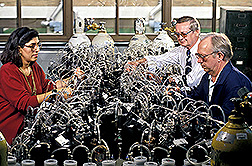|
|
Soy Ink's Superior Degradability
Soybean inks have come a long way! Agricultural Research Service scientists began developing soy inks in 1988 when the American Newspaper Publishers Association and the American Soybean Association requested ARS help.
Now known as the Newspaper Association of America, this organization and the soybean association had three objectives. They wanted a soybean-based ink to lessen the industry's reliance on petroleum in ink products, and they wanted to use more environmentally friendly inks. They were also seeking a soy ink that could be cost-competitive with commercial petroleum-based printing inks.
Newspaper printing inks are made up of pigments carried by a thick fluid, or vehicle. Made from petroleum-based chemicals, pigments are a component of all inks—even soy inks—to provide color. Because of the pigments and a few other chemicals, soy ink isn't 100 percent degradable.
But ARS chemists Sevim Erhan and Marvin O. Bagby have developed new soy ink formulas with more soybean oil, less pigment.
"Using more soy oil in the vehicle means that less pigment (black, blue, red, and yellow) is needed, because the soy oil provides a lighter vehicle," says Erhan. And soy-based printing inks contain no volatile organic compounds.
VOC emissions are restricted in many cities with air quality problems. "Using more soy oil in ink formulas would make compliance with the Clean Air Act easier for printers," says George Fuchs. He is manager of environmental affairs for the National Association of Printing Ink Manufacturers.
Bagby, who heads oil chemical research at the ARS National Center for Agricultural Utilization Research in Peoria. Illinois, says the new ink is five times as degradable as petroleum-based commercial inks. The degradability of the ARS formula--the vehicle with the pigment--was demonstrated in tests performed in 1994.
The results: 80 percent of ARS' soy ink vehicle degraded in 25 days. By comparison, just 30 percent of an ink vehicle containing 67 percent soybean oil degraded. And only 16 percent of a petroleum-based ink vehicle degraded in 25 days. Each formulation contained exactly the same amount and type of pigment.
"Making soy inks more degradable can help disposal problems associated with using petroleum-based or hybrid soy-petroleum inks." says Erhan.
She's testing the various ink formulations in sewage sludge from the Greater Peoria Sanitary District. The sludge should contain micro-organisms representative of the types found in landfills throughout the country. The results of this study will he ready in the spring of 1995.
"We're also developing the first scientific guidelines for evaluating ink biodegradability," says Bagby. — By Linda Cooke, ARS.
Sevim Erhan is in the USDA-ARS Oil Chemical Research Unit, National Center for Agricultural Utilization Research, 1815 N. University, Peoria, IL 61604; phone (309) 681-6532, fax (309) 681-6340.
"Soy Ink's Superior Degradability" was published in the January 1995 issue of Agricultural Research magazine.







